|
|
A translation of this page is available in
Outreach
What is meiofauna?
 |
The term "meiofauna" was first used in 1942 by Mare to define an assemblage of mobile invertebrates distinguished
from macrofauna by their smaller size (meio means smaller in Greek).
Meiofauna is defined by size based on the standard mesh width of sieves with
500 - 1000 Ám as upper and 32 - 63 Ám as lower limit.
The meiofauna has representatives from 23 phyla and is therefore more phylogenetically diverse than any other component
of the marine biota. This initially subjective size-range of benthic invertebrates has since been
shown to represent a discrete, ecologically defined group of organisms whose morphology, physiology and life-history
characteristics have evolved to exploit the interstitial matrix of marine sediments
(see: Meiofauna pictures).
Compared to the macrofauna, meiofauna has a low standing stock. Nevertheless, the higher turn-over rate of meiobenthos
usually generates a high production, frequently exceeding that of macrofauna. In undisturbed environments, meiofauna
(with nematodes and harpacticoid copepods dominating) have been calculated to consume twice the amount of carbon and
to produce four times as much as the macrofauna with only about half its biomass. It seems as if for the comparatively
slowly growing macrofauna, the fixation of energy is dominating whereas for the smaller meiofauna,
the production and turn-over of energy is paramount.
|
 |
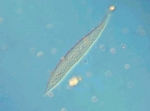 |
Effects of increased rainfall on meiofaunal assemblages
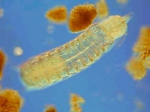 |
Meiofauna are small, mobile invertebrates (see: What is meiofauna?)
Due to their high abundance and diversity, omnipresent distribution, rapid generation times and fast metabolic rates,
they have an important role in ecosystem functioning. Thus the state of meiofaunal assemblages may reflect the overall
health of the bottom of the sea. |
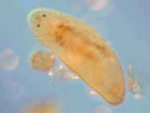 |
| Our knowledge of marine meiofaunal taxonomy and ecology has advanced considerably in the last 25 years.
Meiofauna can be found in all marine (from the beach to the deep sea, and from the poles the equator)
and estuarine environments, can be maintained in relatively small volumes of sediment. Additionally, they have
short life-cycles (1 to 3 months) so that changes in community structure can be observed in short-term studies.
Therefore, the use of meiofaunal assemblages to assess the effects of natural and man-made perturbations in marine
ecosystems has increased significantly.
As a consequence of the changing climate, an increase in the frequency and intensity of storms is expected,
bringing along an important higher amount of rainfall. This will impact organisms that are adapted to life
in marine environments.
Meiobenthic organisms encountered immediately above the swash zone of beaches are dominated by marine organisms.
These are adapted to the alternating influence of the tides and can overcome short term periods of fresh water input
(rainfall during low tide). Marine nematodes, even of intertidal areas, will however explode in fresh water environments
due to osmotic stress. |
 |
 |
A field manipulation experiment was carried out at four geographically separated European beaches,
investigating the response of meiofaunal communities to increased intensity and frequency of rainfall as predicted
by climate change models.
 |
It is hypothesized that de composition of the meiobenthic communities will change as a
consequence of strong increased fresh water impacts. To test a universal response of coastal meiobenthic communities
to strong increased fresh water input, a period of heavy rainfall was mimicked on the beaches.
- The experimental sites are located at
- Arina
- De Panne
- Hel
- Sines
|
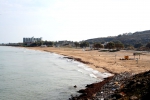 |
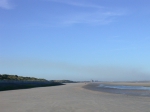 |
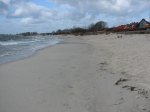 |
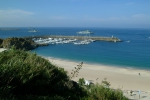 |
Arina
(Crete, Mediterranean Sea):
macrotidal, dissipative beach |
De Panne
(Belgium, North Sea):
macrotidal, dissipative beach |
Hel
(Poland, Baltic Sea):
microtidal beach |
Sines
(Portugal, Atlantic coast):
macrotidal, dissipative beach |
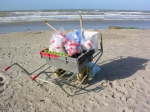 |
 |
 |
 |
 |
| transporting the sampling equipment to the beach |
drawing the sampling plots |
taking the samples with corers |
slicing the samples into layers of 1 cm thick |
collecting the samples for transport to the lab |
More pictures of the rainfall experiment ...
Links to other meiofaunal websites
|
MANUELA is a Responsive Mode Project undertaken within the MarBEF EU Network of Excellence, funded under the  Sixth Framework Pro - gramme of the European Union Sixth Framework Pro - gramme of the European Union
Principal investigator: Jan Vanaverbeke
Total page hits: 375401 - Total visitors: 191633 (since 2006-01-12 for this RMP)
Web contact Leen Vandepitte |
